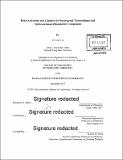Bond activation and catalysis by nontrigonal tricoordinate and tetracoordinate phosphorus compounds
Author(s)
Lin, Yi-Chun, Ph. D. Massachusetts Institute of Technology
DownloadFull printable version (24.69Mb)
Other Contributors
Massachusetts Institute of Technology. Department of Chemistry.
Advisor
Alexander Radosevich.
Terms of use
Metadata
Show full item recordAbstract
Molecular distortion has a profound impact on the electronic structure and reactivity of molecules. This dissertation describes studies on E-H bond activation and catalytic reactivity of [sigma]³- and [sigma]⁴ -phosphorus compounds with distorted nontrigonal structures. Specifically, a rare example of N-H oxidative addition to a planar, C2v-symmetric P(III) center is described in Chapter 2. The kinetics and computational studies implicate a noncanonical, phosphorus-based electrophilic pathway for this transformation. As detailed in Chapter 3, a Cs-symmetric phosphorous triamide and its P-N cooperative reactivity are presented. B-H activation and catalytic imine hydroboration are achieved via the combination of the electrophilic phosphorus center and the basic anilide ligand moiety of this Cs-symmetric phosphorus compound. Finally, Chapter 4 extends the study of distorted phosphorus compounds to [sigma]⁴ -phosphorus molecules. Iminophosphoranes bearing constrained ligand platforms are synthesized and their distortion-induced B-H, B-O and Si-H bond activation reactivity are presented. This research provides insight into the influence of molecular symmetry on the reactivity of [sigma]³- and [sigma]⁴-phosphorus compounds and represents an initial step toward the discovery of new chemistry in other distorted phosphorus molecules.
Description
Thesis: Ph. D., Massachusetts Institute of Technology, Department of Chemistry, 2017. Cataloged from PDF version of thesis. Vita. Includes bibliographical references.
Date issued
2017Department
Massachusetts Institute of Technology. Department of ChemistryPublisher
Massachusetts Institute of Technology
Keywords
Chemistry.